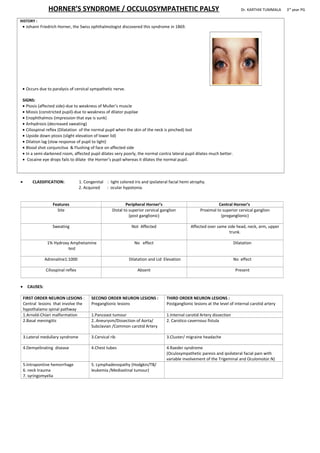Horner's syndrome
•Transferir como DOC, PDF•
8 gostaram•1,590 visualizações
Horner's syndrome is caused by paralysis of the cervical sympathetic nerve, resulting in ptosis, miosis, enophthalmos, anhydrosis, and loss of the ciliospinal reflex on the affected side. It can be classified as congenital or acquired. Peripheral Horner's syndrome occurs distal to the superior cervical ganglion, while central Horner's syndrome occurs proximal to the ganglion. Causes include lesions of the first order neuron in the hypothalamo-spinal pathway, preganglionic lesions of the second order neuron, or postganglionic lesions at the level of the internal carotid artery.
Denunciar
Compartilhar
Denunciar
Compartilhar

Recomendados
Recomendados
Mais conteúdo relacionado
Mais procurados
Mais procurados (20)
Arnold Chiari Malformation And Dandy Walker Syndrome.pptx

Arnold Chiari Malformation And Dandy Walker Syndrome.pptx
BRAINSTEM LESION INVOLVING 3rd,4th and 6th cranial nerve

BRAINSTEM LESION INVOLVING 3rd,4th and 6th cranial nerve
Nerves conduction study, Axonal loss vs Demyelination

Nerves conduction study, Axonal loss vs Demyelination
Semelhante a Horner's syndrome
Lecture on Pupillary Reflexes; Common Abnormalities For 4th Year MBBS Undergraduate Students By Prof. Dr. Hussain Ahmad KhaqanLecture on Pupillary Reflexes; Common Abnormalities For 4th Year MBBS Undergr...

Lecture on Pupillary Reflexes; Common Abnormalities For 4th Year MBBS Undergr...DrHussainAhmadKhaqan
Semelhante a Horner's syndrome (20)
Cranial nerves - trigeminal and vestibulocochlear nerves

Cranial nerves - trigeminal and vestibulocochlear nerves
bells palsy causes physiotherapy assessment treatment

bells palsy causes physiotherapy assessment treatment
Lecture on Pupillary Reflexes; Common Abnormalities For 4th Year MBBS Undergr...

Lecture on Pupillary Reflexes; Common Abnormalities For 4th Year MBBS Undergr...
Neurological examination lec 1 vision and ocular system

Neurological examination lec 1 vision and ocular system
Ménière's disease it’s definition ,etiopathogenesis and management

Ménière's disease it’s definition ,etiopathogenesis and management
Diseases of Autonomic Nervous System I Autonomic Nervous System II Nervous Sy...

Diseases of Autonomic Nervous System I Autonomic Nervous System II Nervous Sy...
Mais de Kurian Joseph
Mais de Kurian Joseph (20)
Horner's syndrome
- 1. HORNER’S SYNDROME / OCCULOSYMPATHETIC PALSY Dr. KARTHIK TUMMALA 3rd year PG HISTORY : • Johann Friedrich Horner, the Swiss ophthalmologist discovered this syndrome in 1869. • Occurs due to paralysis of cervical sympathetic nerve. SIGNS: • Ptosis (affected side)-due to weakness of Muller’s muscle • Miosis (constricted pupil)-due to weakness of dilator pupilae • Enophthalmos (impression that eye is sunk) • Anhydrosis (decreased sweating) • Ciliospinal reflex (Dilatation of the normal pupil when the skin of the neck is pinched) lost • Upside down ptosis (slight elevation of lower lid) • Dilation lag (slow response of pupil to light) • Blood shot conjunctiva & Flushing of face on affected side • In a semi-darkened room, affected pupil dilates very poorly, the normal contra lateral pupil dilates much better. • Cocaine eye drops fails to dilate the Horner’s pupil whereas it dilates the normal pupil. • CLASSIFICATION: 1. Congenital : light colored iris and ipsilateral facial hemi atrophy. 2. Acquired : ocular hypotonia. Features Peripheral Horner’s Central Horner’s Site Distal to superior cervical ganglion (post ganglionic) Proximal to superior cervical ganglion (preganglionic) Sweating Not Affected Affected over same side head, neck, arm, upper trunk. 1% Hydroxy Amphetamine test No effect Dilatation Adrenaline1:1000 Dilatation and Lid Elevation No effect Ciliospinal reflex Absent Present • CAUSES: FIRST ORDER NEURON LESIONS : Central lesions that involve the hypothalamo spinal pathway SECOND ORDER NEURON LESIONS : Preganglionic lesions THIRD ORDER NEURON LESIONS : Postganglionic lesions at the level of internal carotid artery 1.Arnold-Chiari malformation 1.Pancoast tumour 1.Internal carotid Artery dissection 2.Basal meningitis 2..Aneurysm/Dissection of Aorta/ Subclavian /Common carotid Artery 2. Carotico cavernous fistula 3.Lateral medullary syndrome 3.Cervical rib 3.Cluster/ migraine headache 4.Demyelinating disease 4.Chest tubes 4.Raeder syndrome (Oculosympathetic paresis and ipsilateral facial pain with variable involvement of the Trigeminal and Oculomotor.N) 5.Intrapontine hemorrhage 6. neck trauma 7. syringomyelia 5. Lymphadenopathy (Hodgkin/TB/ leukemia /Mediastinal tumour)
